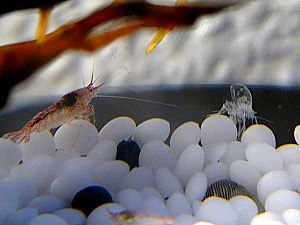Hawaiian red shrimp facts for kids
Quick facts for kids Halocaridina rubra |
|
|---|---|
 |
|
| Ovigerous ʻōpaeʻula | |
| Scientific classification | |
| Kingdom: | |
| Phylum: | |
| Subphylum: | |
| Class: | |
| Order: | |
| Infraorder: | |
| Family: |
Atyidae
|
| Genus: |
Halocaridina
|
| Species: |
H. rubra
|
| Binomial name | |
| Halocaridina rubra Holthuis, 1963
|
|
The Halocaridina rubra is a tiny red shrimp. It is also known as the Hawaiian red shrimp or volcano shrimp. In the Hawaiian language, its name is ʻōpaeʻula, which means "red shrimp".
Contents
Where Do These Tiny Shrimp Live?
This small red shrimp is usually less than 1.5 cm (0.6 in) long. You can often find them in brackish water pools near the ocean. Brackish water is a mix of fresh water and salty ocean water. These special pools are called anchialine pools. The word "anchialine" comes from a Greek word meaning "near the sea."
Halocaridina rubra is found only in the Hawaiian Islands. This means they are endemic to Hawaii. They are most common in anchialine pools that form in fresh lava on the islands of Hawaiʻi and Maui. They have also been found in limestone karst pools and underground places on older islands like Oʻahu. Their unique homes are found on five of the eight main Hawaiian Islands: Maui, Kahoʻolawe, Oʻahu, Molokaʻi, and Hawaiʻi.
What Do Hawaiian Red Shrimp Eat?
ʻŌpaeʻula shrimp are herbivores and detritivores. This means they eat plants and tiny bits of decaying matter. They live in both underground (hypogeal) and surface (epigeal) parts of anchialine pools.
Their main food is algae and bacteria that grow in mats on rocks and other surfaces in the pools. Their front claws, called Chelipeds, are perfect for scraping and filtering these food layers. They have special bristles that scrape the surface and other hair-like bristles that collect the loosened food. These bristles can also act like filters to catch tiny floating plants (called phytoplankton) when there are many of them.
The way these shrimp graze helps keep the "crust" healthy. This crust is a living layer of plants, bacteria, and other tiny creatures on the rocks. The Halocaridina shrimp are very well suited to their unique pool homes. They even reproduce in the hidden, underground parts of their habitat.
Keeping Hawaiian Red Shrimp as Pets
Recently, ʻōpaeʻula have become popular pets, especially in Hawaii. People like them because they are easy to care for. These shrimp can live a long time, sometimes up to 20 years, when kept in tanks!
It's hard to tell male and female shrimp apart. However, female shrimp that are ready to lay eggs (called gravid females) carry clusters of red or maroon eggs under their bodies. The baby shrimp are tiny and float around, eating by filtering the water.
These shrimp occasionally shed their outer shells, a process called molting. You might see their old, silvery exoskeletons at the bottom of the tank. Some people think that ʻōpaeʻula might mate after they molt, or that molting and mating are connected.
When ʻōpaeʻula are stressed, they tend to hide. But if you give them lots of places to hide, they are more likely to come out into open spaces. They are social creatures and rarely fight. In fact, when they are not stressed, they often gather together while eating or sunbathing. You might also see them cleaning themselves or swimming slowly around their tank.
These shrimp are also the animal used in the Ecosphere, which is a special sealed aquarium that creates its own tiny ecosystem.
Images for kids




